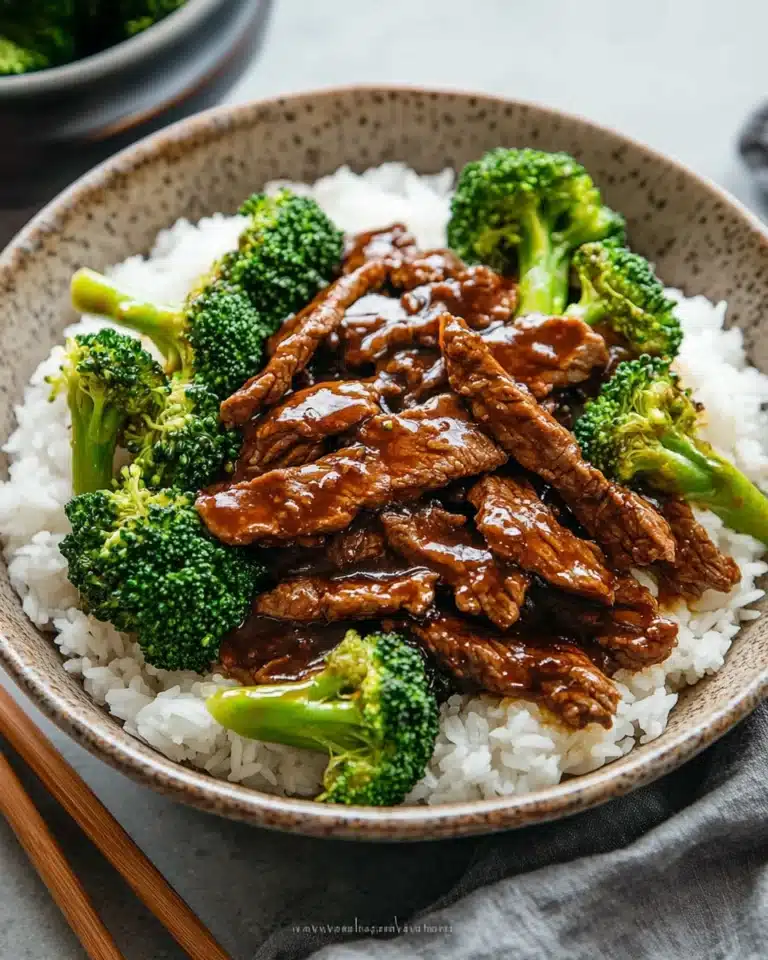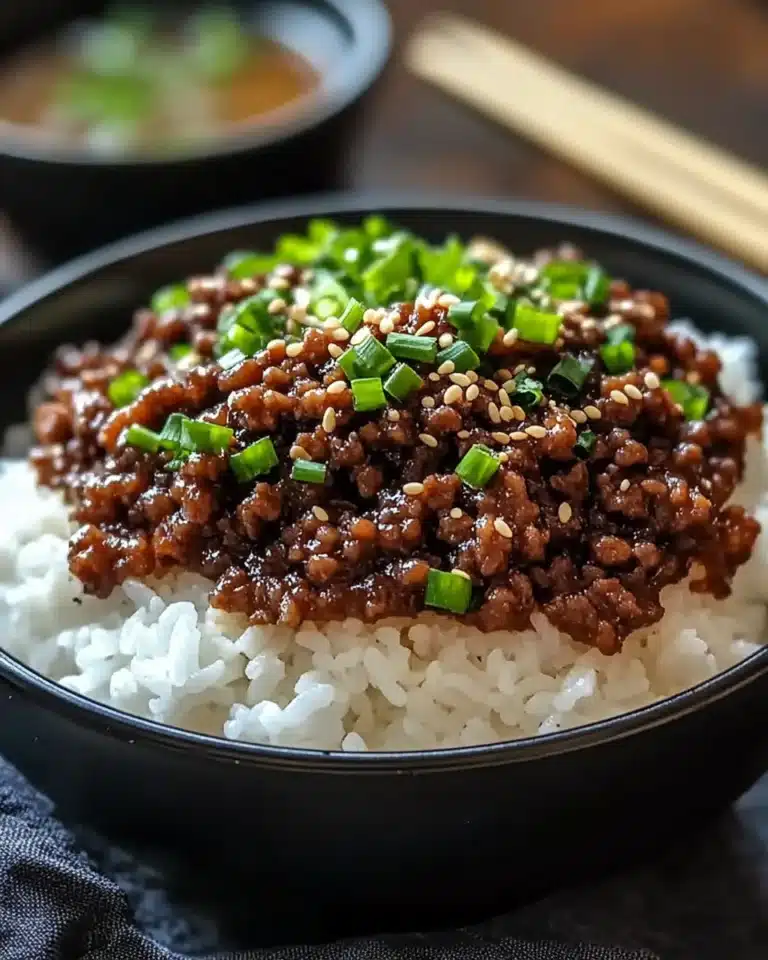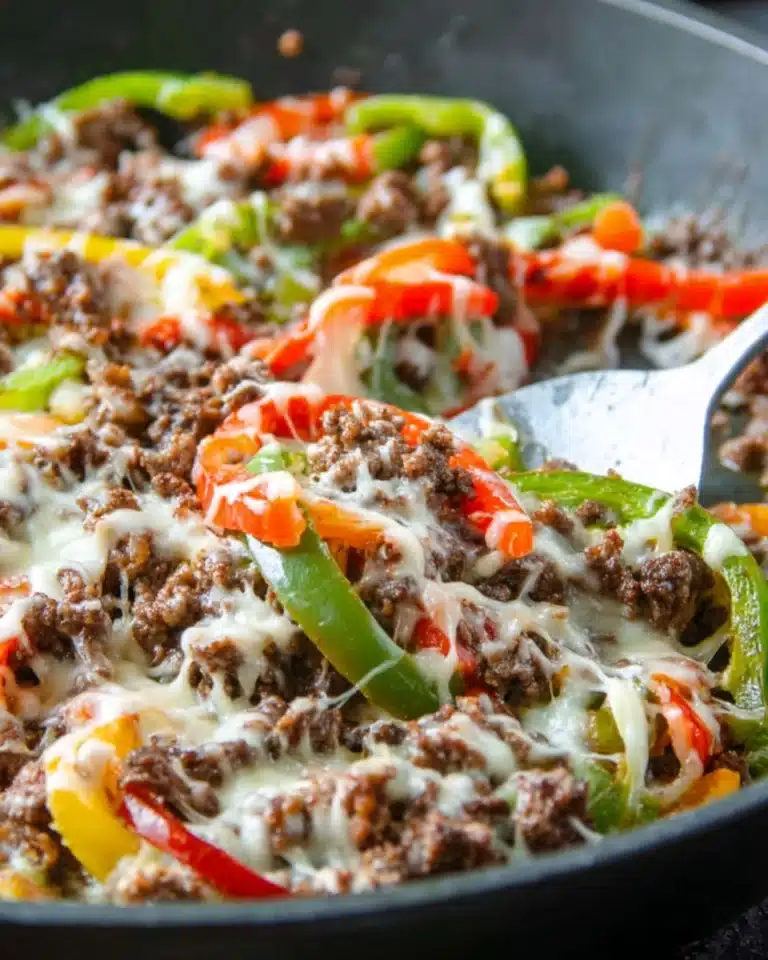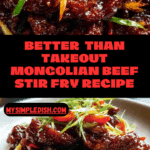If you’re looking for a Chinese takeout classic that’s incredibly delicious and surprisingly easy to whip up at home, Mongolian Beef is the answer! This dish features tender slices of beef that are crispy on the outside and irresistibly juicy inside, all tossed in a glossy, sweet and savory sauce with colorful bell peppers and onions. From the first bite, Mongolian Beef’s rich garlic-ginger aroma, deep umami notes, and just the right hint of honey sweetness make it an absolutely unforgettable meal that’s bound to impress family and friends.
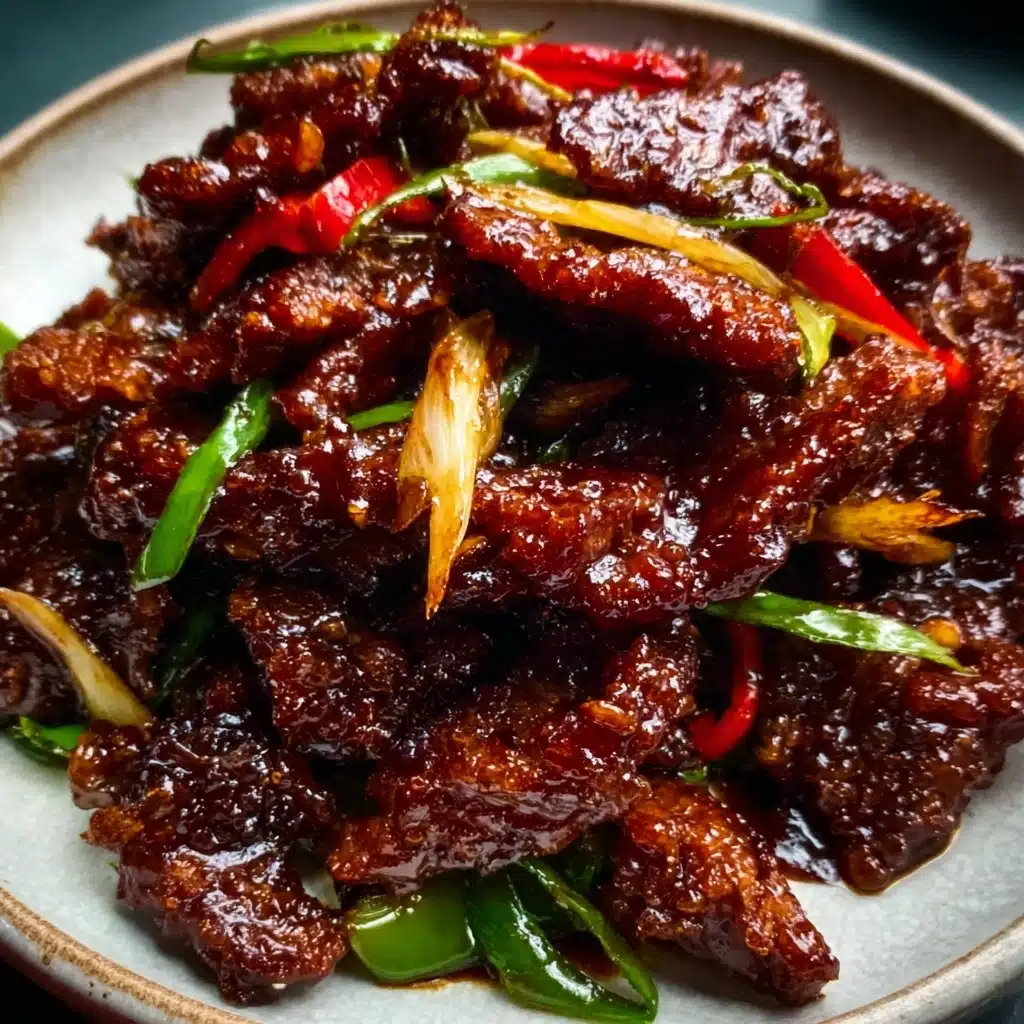
Ingredients You’ll Need
The magic of Mongolian Beef comes down to a handful of easy-to-find but totally essential ingredients. Each one is chosen not just for flavor, but for the role it plays in creating the classic taste and irresistible texture of this beloved dish.
- Beef steak (flank, sirloin, or rib eye): The star of the show; make sure to slice it against the grain for extra tenderness.
- White onion: Adds sweetness and a gentle crunch, balancing out the savory sauce.
- Red bell pepper: Brightens up the dish with color and a delicate sweetness.
- Fresh ginger: Gives a peppery, slightly spicy kick that infuses the oil.
- Garlic cloves: Essential for that mouthwatering, aromatic foundation.
- Green onions: Their mild flavor and vivid green hue make them perfect for finishing the dish.
- Soy sauce: Used in both the marinade and sauce for savory depth and that classic umami base.
- Sesame oil: A little goes a long way to bring nutty aroma and a touch of luxury.
- Shaoxing wine (optional): Adds an authentic depth that enhances the beef’s flavor.
- Cornstarch: Key for both velveting the beef and thickening the luscious sauce.
- Honey (or sugar): Rounds out the sauce, giving it that signature glossy look and subtle sweetness.
- Hoisin sauce: Brings complex, sweet-salty flavor and rich color to the sauce.
- Oyster sauce: Gives an extra umami boost and silkiness to the final dish.
- Chinese five spice: A pinch delivers warm, aromatic intrigue.
- Cooking oil: Needed for both frying and stir-frying.
- Water: Helps create the perfect consistency for marinating and saucing.
How to Make Mongolian Beef
Step 1: Prep the Vegetables and Aromatics
Start by slicing the ginger and finely slicing the garlic cloves, then cut the green onions into two-inch sticks, slicing the whites lengthwise. Thinly slice the white onion and separate the pieces, then repeat with the red bell pepper. Having all your veggies and aromatics chopped and ready makes everything move smoothly once the cooking starts!
Step 2: Marinate the Beef
Grate your ginger, onion, and garlic, then combine them in a mixing bowl with soy sauce, sesame oil, Shaoxing wine (if using), and a splash of water. Thinly slice your beef steak against the grain, which keeps each bite super tender, and toss it in the marinade. Let it sit for a minimum of 15 minutes to soak up all those flavors. When you’re ready to cook, sprinkle on the cornstarch and mix until every slice is coated, then add a bit of oil to lock in moisture. Set aside—your kitchen already smells amazing, right?
Step 3: Mix the Mongolian Beef Sauce
For that signature sticky-sweet glaze, mix cornstarch and soy sauce first (this little trick keeps everything ultra-smooth). Whisk in honey, hoisin sauce, oyster sauce, Chinese five spice, sesame oil, Shaoxing wine, and cold water. Stir until homogenous and set aside: this sauce is pure magic and worth every ingredient.
Step 4: Cook the Beef (Deep Fry or Pan Fry)
You’ve got two options for the beef: deep fry for that irresistible crispy crunch, or pan fry for a lighter (but still flavorful!) finish. Deep frying? Heat at least an inch of oil to bubbling-hot, then cook the beef in small batches for a few minutes until golden and crispy. Or, in a skillet or wok with a thin layer of oil, sear the beef pieces so they brown up beautifully. No matter which method you choose, remove the cooked beef and set it aside.
Step 5: Stir-Fry and Finish the Mongolian Beef
Crank the pan back to medium-high, add a splash more oil, and toss in your ginger slices. Let them sizzle for a couple minutes to infuse the oil, then add the garlic, onions, and red bell peppers. Give them a quick toss for a minute or two, just until fragrant. Stir your sauce again (cornstarch settles—this is a handy tip!), push the veggies aside, and pour in the sauce. Stir until it thickens and the color goes from light to rich, dark brown. Now, toss in all your cooked beef and green onions, give everything a quick stir to coat in the glossy sauce, and cook for about a minute more. Remove ginger slices, plate up, and sprinkle generously with sesame seeds. That’s Mongolian Beef perfection!
How to Serve Mongolian Beef
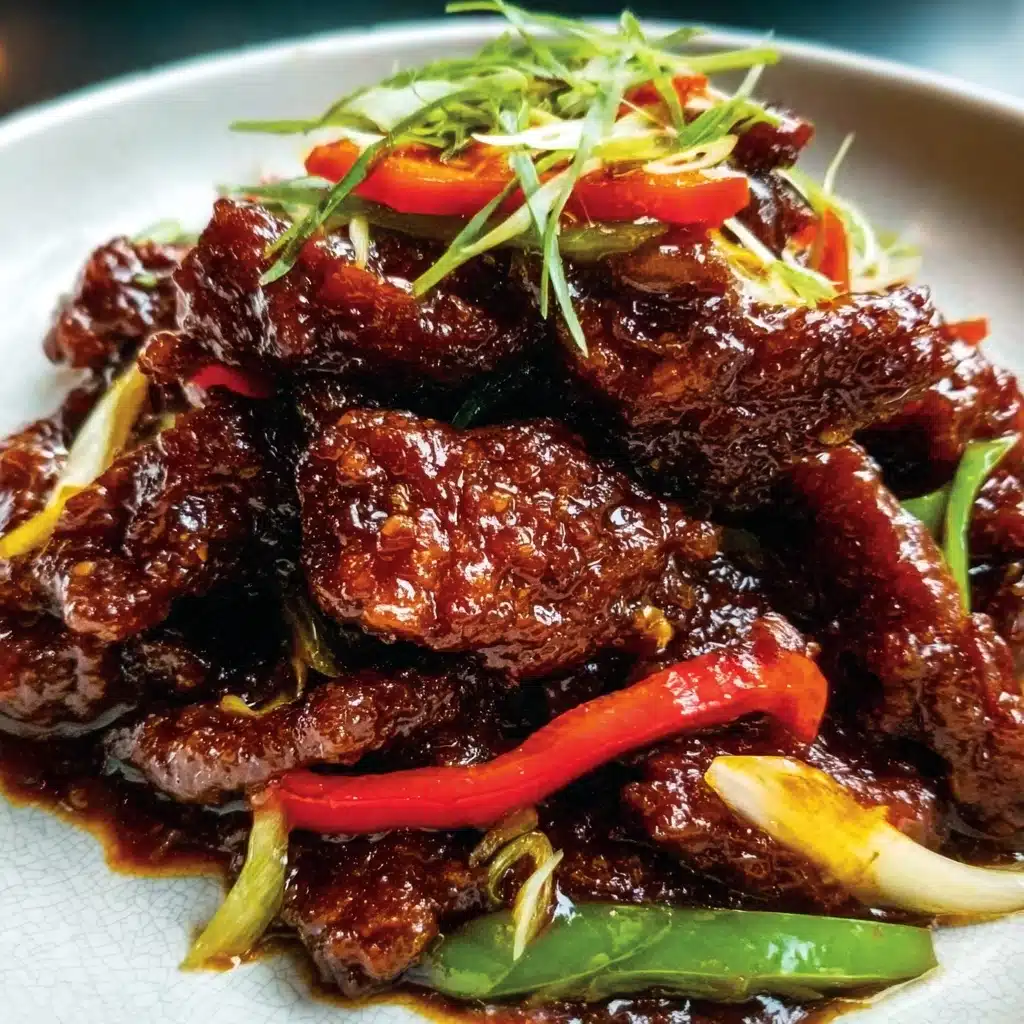
Garnishes
An extra flourish of freshly sliced green onions and toasted sesame seeds right before serving elevates Mongolian Beef, adding freshness and a gentle crunch. If you want to bring out its restaurant-style charm, try a light dusting of crushed red pepper flakes for a gentle heat, or even a few sprigs of cilantro if you love a hint of herbal brightness.
Side Dishes
Nothing complements Mongolian Beef quite like a heap of fluffy steamed white rice to soak up that glossy sauce. For a lighter touch, try jasmine rice, brown rice, or even cauliflower rice. Steamed broccoli, sautéed snow peas, or a crisp cucumber salad are all great options to round out your meal and bring some color and crunch alongside your sizzling beef.
Creative Ways to Present
For a fun twist, serve Mongolian Beef in lettuce cups for a hand-held, party-perfect bite (kids love this!). Or take a nod from bento-style meals and layer it over rice in individual bowls, topped with a jammy soft-boiled egg and quick-pickled veggies. If you’re hosting, arrange the beef and veggies on a large platter, letting your guests build their plates just the way they like.
Make Ahead and Storage
Storing Leftovers
If you find yourself with extra Mongolian Beef, let it cool to room temperature before transferring it to an airtight container. It’ll keep happily in the fridge for up to three days, and the flavors actually deepen a little overnight, making leftovers a real treat!
Freezing
Yes, you can freeze Mongolian Beef! Portion it into freezer-safe bags or containers, making sure to press out any excess air. It’ll keep for up to two months. Thaw overnight in the fridge for best results, and be ready for a nearly instant dinner the next day.
Reheating
For best texture, reheat Mongolian Beef in a skillet or wok over medium heat until hot and the sauce is bubbling. If needed, add a splash of water to loosen up the sauce. Microwaving in short bursts also works, but keep an eye on it to avoid overcooking the beef. It’s just as good the second time around!
FAQs
What type of beef is best for Mongolian Beef?
Flank steak is ideal, but sirloin or rib eye also work beautifully. The key is slicing the beef thinly against the grain for the most tender texture.
Can I make Mongolian Beef gluten-free?
Absolutely! Simply swap out the soy sauce for a gluten-free tamari or coconut aminos, and double-check that your hoisin and oyster sauces are certified gluten-free too.
How spicy is Mongolian Beef?
Traditional Mongolian Beef isn’t very spicy at all. If you prefer more heat, toss in some sliced fresh chilies or a sprinkling of crushed red pepper to amp things up!
Is there a way to make Mongolian Beef vegetarian?
Definitely. Try swapping the beef for pan-fried firm tofu or even seitan. Adjust the sauce to taste and you’ll still get all those iconic flavors in every bite.
Why is cornstarch important in this recipe?
Cornstarch helps the beef achieve that light, barely-there crispiness, and also thickens the sauce to that luscious, glossy finish Mongolian Beef is known for.
Final Thoughts
If you’ve ever wished you could bring a Chinese restaurant favorite to your own kitchen, Mongolian Beef is the dish to try. With its bold flavors, satisfying textures, and enticing aroma, it’s sure to become a regular in your dinner rotation. Gather your ingredients and treat yourself to a homemade meal that tastes just as good as takeout—if not better!
Print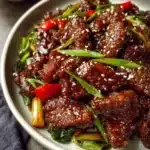
Mongolian Beef Recipe
- Total Time: 35 minutes
- Yield: 2-3 servings
- Diet: Halal
Description
This classic Mongolian Beef recipe features tender beef stir-fried with fresh vegetables and tossed in a savory-sweet sauce, making it the perfect homemade alternative to your favorite Chinese takeout. With a rich umami flavor balanced by aromatic ginger and garlic, this quick and satisfying dish is ideal for busy weeknights and special occasions alike.
Ingredients
Vegetables & Aromatics
- 1/2 white onion (approx. 3/4 cup), sliced
- 1/2 red bell pepper (approx. 3/4 cup), thinly sliced
- 4–5 slices ginger
- 3 cloves garlic, thinly sliced
- 1–2 stalks green onions, cut into 2-inch pieces
Beef
- 300 g beef steak (flank, sirloin, or rib eye work well), thinly sliced against the grain
Beef Marinade
- 1 tablespoon soy sauce
- 1/2 teaspoon sesame oil
- 2 tablespoons water
- 1/2 tablespoon grated garlic (approx. 2 cloves)
- 1/2 teaspoon grated ginger
- 1/2 tablespoon grated onion (approx. 1/4 small onion)
- 1/2 tablespoon Shaoxing wine (optional)
- 3 tablespoons cornstarch (added after marinating)
- 1 tablespoon oil (added after marinating)
Mongolian Beef Sauce
- 2 tablespoons soy sauce (low sodium)
- 1 tablespoon cornstarch
- 3 tablespoons honey (or sugar)
- 2 tablespoons hoisin sauce
- 1 tablespoon oyster sauce
- 1/4 teaspoon Chinese five spice
- 1/2 tablespoon sesame oil
- 1 tablespoon Shaoxing wine
- 1/2 cup cold water
For Cooking
- Oil (for deep frying or pan frying)
- Sesame seeds for garnish (optional)
Instructions
- Prepare the Aromatics and Vegetables: Slice the ginger (4-5 slices) and garlic (3 cloves) thinly, and set aside. Cut the green onions (1-2 stalks) into 2-inch pieces, slicing the white parts lengthwise. Slice 1/2 white onion and 1/2 red bell pepper thinly and set aside.
- Marinate the Beef: Grate the ginger (1/2 teaspoon), onion (1/2 tablespoon), and garlic (1/2 tablespoon) into a bowl. Thinly slice the beef steak (300 g) against the grain and add to the bowl. Add soy sauce (1 tbsp), water (2 tbsp), sesame oil (1/2 tsp), and Shaoxing wine (1/2 tbsp, optional). Combine well and let it marinate for at least 15 minutes. After marinating, mix in cornstarch (3 tbsp) until the beef is coated, then add oil (1 tbsp) and mix again. Set aside.
- Prepare the Sauce: In a small bowl, mix cornstarch (1 tbsp) with soy sauce (2 tbsp) until dissolved. Add honey (3 tbsp or sugar), hoisin sauce (2 tbsp), oyster sauce (1 tbsp), Chinese five spice (1/4 tsp), sesame oil (1/2 tbsp), Shaoxing wine (1 tbsp), and cold water (1/2 cup). Mix thoroughly and set aside.
- Cook the Beef (Choose One Method):
– Deep Frying: Heat at least 1 inch of oil in a pot over medium heat. When hot, fry the beef slices in batches for 3-5 minutes until browned and crispy. Remove and set aside.
– Pan Frying: Heat a generous layer of oil in a large skillet or wok over medium-high heat. Once hot, add beef slices in batches, ensuring you don’t overcrowd the pan. Sear until browned, then remove and set aside. - Stir-Fry Everything: With the pan over medium-high heat, add oil and toast the ginger slices for about 2 minutes. Add the garlic slices, red pepper, and white onion, stir-frying for 1-2 minutes. Push veggies aside, stir the sauce (as cornstarch may settle), and pour it into the pan. Stir until the sauce thickens and becomes dark brown.
- Combine and Finish: Add the cooked beef and green onions to the pan. Stir-fry everything together, coating evenly in the sauce for about 1 minute. Remove the ginger slices before serving. Plate the dish, garnish with sesame seeds if desired, and serve hot.
Notes
- Slice beef thinly against the grain for maximum tenderness.
- Marinate beef for longer if you have time for deeper flavor.
- If you’d like a spicier version, add dried chili flakes or sliced chili with the aromatics.
- For a lighter option, choose pan frying instead of deep frying.
- This dish pairs well with steamed jasmine rice or stir-fried noodles.
- Leftovers can be stored in an airtight container in the fridge for up to 3 days.
- Prep Time: 15 minutes
- Cook Time: 20 minutes
- Category: Main-course
- Method: Stovetop
- Cuisine: Chinese
Nutrition
- Serving Size: 1 serving (approx. 1/2 of total recipe)
- Calories: 490
- Sugar: 22g
- Sodium: 985mg
- Fat: 28g
- Saturated Fat: 9g
- Unsaturated Fat: 16g
- Trans Fat: 1g
- Carbohydrates: 38g
- Fiber: 2g
- Protein: 20g
- Cholesterol: 71mg

